Facts and data on pictograms

Synonyms / Other Terms Used
Direction Arrow, Directional Arrow, Direction Indicator
Category
Directions, General Access, Public Facilities, Design Basics
Message / Function
To indicate direction of movement of people
Note: Only to be used in conjunction with other symbols
| Source | Description | |
|---|---|---|
 |
De La Mare & Walker |
Arrow with Belgian head, LWR 2.11, DHR 0.50, WHR 0.31 |
 |
Tern | Arrow with Belgian head, LWR 1.66, DHR 0.58, WHR 0.33 |
 |
ISO 7001 | Arrow with Belgian head, angle at apex of between 84° and 86°, LWR 1.60, DHR 0.66, WHR 0.36 |
 |
MDCT | Arrow with Belgian head, LWR 1.27, DHR 0.72, WHR 0.33 |
 |
Aragón | Arrow with Belgian head, angle at apex 90°, LWR 1.01, DHR 0.76, WHR 0.19 |
 |
AIGA | Arrow with Belgian head, LWR 1.19, DHR 0.69, WHR 0.24 |
 |
Eco-Mo Foundation |
Arrow with Belgian head, LWR 1.20, DHR 0.63, WHR 0.20 |
 |
NMS | Arrow with Belgian head, LWR 1.17, DHR 0.57, WHR 0.15 |
 |
ÖBB 2007 | Arrow with Belgian head, LWR 1.43, DHR 0.56, WHR 0.18 |
 |
STVO D | Arrow with Belgian head, LWR 1.63, DHR 0.48, WHR 0.23 |
 |
ICAO | Arrow with Belgian head, LWR 2.06, DHR 0.39, WHR 0.19 |
 |
OS Berlin | Arrow with Belgian head, LWR 1.50, DHR 0.38, WHR 0.05 |
 |
EJP | Arrow with flat line ends, LWR 0.98, DHR 0.56, WHR 0.09 |
 |
Transit Pict One | Arrow with flat line ends, LWR 1.15, DHR 0.53, WHR 0.15 |
 |
Skandia 1998 | Arrow with flat line ends, LWR 2.03, DHR 0.33, WHR 0.23 |
 |
Dreyfuss | Arrow with flat line ends, LWR 2.27, DHR 0.31, WHR 0.20 |
 |
OSKZ Seefeld | Arrow with round line ends, LWR 1.31, DHR 0.45, WHR 0.19 |
 |
D'source | Arrow with round line ends, LWR 1.20, DHR 0.48, WHR 0.16 |
 |
Miraikan | Arrow with rounded line ends, LWR 1.02, DHR 0.57, WHR 0.13 |
 |
Cascadia Code | Arrow with flat line ends and blunt head, angle at apex 91° to 92°, LWR 0.99, DHR 0.56, WHR 0.18 |
 |
Dejavu Sans | Arrow with flat line ends and blunt head, LWR 1.71, DHR 0.34, WHR 0.20 |
 |
De La Mare & Walker |
Arrow with blunt Belgian head, LWR 1.96, DHR 0.41, WHR 0.23 |
 |
CGN | Arrow with rounded line ends and blunt head, LWR 1.41, DHR 0.46, WHR 0.20 |
 |
ATH | Arrow with Belgian head, angle at apex 112°, LWR 1.36, DHR 0.44, WHR 0.24 |
 |
SVI | Arrow with swept-back delta head with slightly rounded corners, angle at apex 61°, LWR 1.79, DHR 0.48, WHR 0.32 |
 |
STVO A | Arrow with swept-back delta head with rounded corners, angle at apex 61°, LWR 1.92, DHR 0.48, WHR 0.30 |
 |
Argentina MSV | Arrow with swept-back delta head with rounded corners, angle at apex 75°, LWR 1.96, DHR 0.41, WHR 0.40 |
 |
Argentina MSV | Arrow with 15° swept-back delta head with rounded corners, isosceles trapezoid shaft, angle at apex 62°, LWR 1.08, DHR 0.78, WHR 0.46 |
 |
FHWA | Arrow with 10° swept-back delta head with rounded corners, angle at apex 100°, LWR 0.69, DHR 0.73, WHR 0.20 |
 |
FHWA mod | Arrow with 10° swept-back delta head with rounded corners, angle at apex 100°, LWR 1.07, DHR 0.45, WHR 0.20 |
 |
NARSSM | Arrow with 18° swept-back delta head with rounded corners, isosceles trapezoid shaft, shaft width ratio 1.39, angle at apex 70°, LWR 1.30, DHR 0.57, WHR 0.23 |
 |
Aragón | Arrow with 14° swept-back delta head with rounded corners, isosceles trapezoid shaft, shaft width ratio 1.66, angle at apex 67°, LWR 1.51, DHR 0.50, WHR 0.18 |
 |
De La Mare & Walker |
Arrow with Belgian head, isosceles trapezoid shaft, shaft width ratio 1.90, LWR 1.88, DHR 0.48, WHR 0.28 |
 |
Cambria | Arrow with swept-back tapered wing like blunt head, LWR 1.80, DHR 0.31, WHR 0.16 |
 |
De La Mare & Walker |
Arrow with French head with 45° swept-back delta, LWR 2.0, DHR 0.54, WHR 0.35 |
 |
De La Mare & Walker |
Arrow with British head, LWR 1.89, DHR 0.34, WHR 0.38 |
 |
De La Mare & Walker |
Arrow with British head, LWR 2.00, DHR 0.36, WHR 0.21 |
 |
Wingdings | Arrow with British head, in outline |
 |
SI 2002 | Arrow with British head, in outline, rear end open |
 |
W-RSG | Arrow with British head, isosceles trapezoid shaft, shaft width ratio 2.10, LWR 2.61, DHR 0.32, WHR 0.25 |
 |
De La Mare & Walker |
Arrow with British head, isosceles trapezoid shaft, shaft width ratio 1.73, LWR 1.94, DHR 0.40, WHR 0.29 |
 *) *) |
De La Mare & Walker |
Arrow with British head, isosceles trapezoid shaft, shaft width ratio 3.03, LWR 1.94, DHR 0.40, WHR 0.32 |
 |
designworkplan | Arrow with 9° swept-back delta head with rounded corners, round shaft end |
 |
designworkplan | Arrow with diamond shaped head, shaft tapers smoothly and curves slightly inward ending as solid rectangle |
 |
Aicher & Krampen |
Arrow with kite shaped head |
 |
Aicher & Krampen |
Arrow with heart shaped head |
 |
Arial | Arrow with swept-back tapered wing like blunt head, LWR 2.61, DHR 0.26, WHR 0.14 |
 |
Aicher & Krampen |
Arrow with swept-back tapered wing like head plus forked fletching |
 |
Lerner 1981 | Arrow with British head and forked fletching |
 |
UN 1968 | Solid block arrow with forked tail |
 |
Dreyfuss | Arrow with flat line ends, LWR 2.15, DHR 0.33, WHR 0.21, shaft as dashed line |
 |
Lerner 1981 | Arrow with Belgian head, shaft made of three chevrons, LWR 1.26, DHR 0.67, WHR 0.26 |
 |
DB | Arrow with flat line ends, shaft detached from head |
 |
BRSA | Arrow with Belgian head, shaft detached from head, angle at apex about 100° |
 |
BRSA | Belgian head like chevron, no shaft, angle at apex about 100° |
 |
Hora | Belgian head like chevron, no shaft, angle at apex > 90° |
 |
Dreyfuss | Obtuse isosceles triangle |
 *) *) |
De La Mare & Walker |
Filled acute isosceles triangle, angle at apex about 25° |
 *) *) |
De La Mare & Walker |
Chevron, angle about 25° |
 |
Garvey 2004 | 45° swept-back delta, angle at apex about 40° |
 |
Arial | 30° swept-back delta, upper part in outline, angle at apex about 57° |
 |
Lerner 1981 | Circular/elliptic sector, central angle 60° |
 |
Lerner 1981 | Filled acute isosceles triangle inside triangle cropped by circular frame |
 |
BRSA | Filled acute isosceles triangle cropped by circular frame |
Note:
LWR: Ratio of arrow length to width of arrow
DHR: Ratio of arrow length to depth of arrow head
WHR: Ratio of arrow width to width of arrow head
Shaft width ratio: Ratio of width of shaft at arrow head to width of shaft at arrow end
The accuracy of the numbers presented is dependent on the quality of the artwork available
Some of the examples shown above were rotated to contrast differences and modified concerning shaft length when proportions would not allow acceptable visibility when presented in the size used.
Discussion
The collection shown above is only a small selection of the wide variety of arrows used all over the world to guide people into a certain direction. As signage systems rely heavily on the use of arrows, we also can find lots of variations in typefaces available for such applications. To give an impression of the available range of direction indicators, also arrows intended to be used independently of other symbols, as for example the road sign Right Here, were included, too. To contrast differences we present one direction only in this table.
Several studies present research covering many arrow variants:
To find the optimum shape of arrows to indicate directions, De La Mare & Walker (1962) conducted a study registering visibility distances using systematically varied forms and proportions as shown in the illustration below. Tests were carried out outside in a realistic setting, partially using neutral density filters to impoverish the stimuli presented.
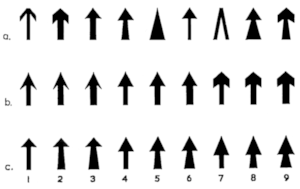
In a first experiment (a) which was primarily focusing on forms, incorrect direction was reported most often for the arrows tagged with *) in our table above. In the second experiment (b) shaft width compared to total arrow width was varied using the arrow heads of French, British and Belgian advance road direction signs. Significantly fewer errors were reported for variations based on the Belgian arrow head, while differences concerning shaft width were not significant. The final experiment investigated proportions of head depth and shaft length (items of line c in the illustration above). Arrows with a short shaft compared to the depth of the head (DHR 0.68) performed significantly less well than the other variants examined. The authors concluded that a simple shafted arrow led to greater distance legibility than unorthodox indicators and if certain dimensional limits were exceeded errors in interpretation occurred.
Markowitz et al. (1968) compared the seven types of arrows shown below on basis of tachistoscopic stimulus presentations:

While arrow type 1 performed best due to the directional information also processed from the presentation of the shaft, arrow type 2 with Belgian head was placed first among the variants with a parallel shaft.
As part of the effort to develop a national standard concerning direction indicators for road signs, Smith & Weir (1978) conducted three experiments using a symbols set based on the studies of Rutley & Christie in 1966. In the two visibility experiments based on variation of blur and contrast symbols 4, 5, 6, and 7 resp. 3, 1, 7, 4, and 2 performed best. In the third experiment, an Appropriateness Ranking Test, arrow 2 with Belgian head was placed first, followed by arrows 1 and 3.
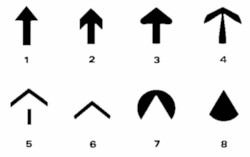
In a paper regarding exit directional symbols (Lerner, 1981), the sixteen directional indicators displayed below were examined under degraded visual conditions, both in black on white and white on black. The arrows labeled N, O, P, and D consistently were associated with the largest error rates, while the direction indicators C, K, L, M and A elicited the lowest number of wrong responses.
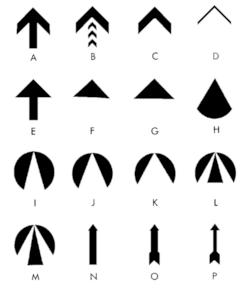
In order to select the most legible guide sign arrows for use on National Park Service signs, Garvey et al. (2004) evaluated a set of twelve arrows in an outdoor field study. The diagram below illustrates the mean legibility distances for the arrows examined. Arrows with a short shaft or no shaft at all seem to convey the directional information not as good as arrows with a clearly visible shaft and head.
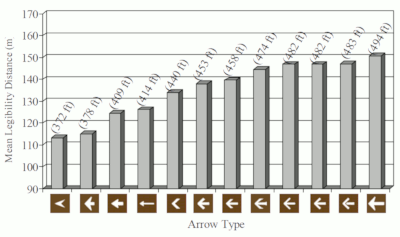
Using the Comprehensibility Estimation procedure to study symbols based on a 64 x 64 matrix-like display format intended for variable message signs, also some signs including arrows were examined. For signs like Road ahead closed, Next exit closed, Take next exit, and Last exit before toll check point results indicate consistent preferences for specific arrow heads throughout this test and for all countries. Symbols showing the solid block arrow with a triangular point, as used in the 20. Convention on Road Signs and Signals (labeled UN 1968 above), were generally judged as least comprehensible (Brugger, 2006).
Regarding studies focusing just on arrows alone, one has to take into account that arrows used in combination with pictograms might not yield identical results, as in this case probably more arrow variants could work well indicating a specific direction. Furthermore arrows are not only used as direction indicators in conjunction with other symbols, but also as elements of pictograms and road signs for example. In such cases other parameters than the ones discussed above may have priority to correctly convey the intended message.
Recommendations
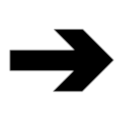
Based on the results of De La Mare & Walker (1962) Krampen recommended in his report to ISO TC 145 WG3 (1974) an arrow design as finally standardized in ISO 7001. We recommend using the arrow from the Tern symbol set, which to us seems to be superior to the arrow used as ISO guidline example.
We further suggest to conduct a detailed study comparing visibility distances of arrows in conjunction with a pictogram, with systematically varied proportions of the arrows used, to identify the perfect arrow proportions.
Tests of symbols to be used as direction indicators
Brugger, Ch. (2006): Comprehensibility Judgement Test. Report In-Safety, 506716.
Bryant, J.F.M., and Smith, G. (1976). The shape of traffic signal arrows. ARRB Proceedings, Session 25. Vol. 8, 36-45. *)
De La Mare, G. & Walker, J. (1962): The Visibility of Direction Indicators. Ergonomics, 5(4), 573-579.
Garvey, P., Chirwa, K., Meeker, D., Pietrucha, M., Zineddin, A., Ghebrial, R., & Montalbano, J. (2004): New Font and Arrow for National Park Service Guide Signs. Transportation Research Record. 1862. 1-9. 10.3141/1862-01.
Jainski, P. (1963): The visibility distance of directional arrows on traffic signals. Straße und Autobahn, 14, 353. *)
Lerner, N.D. (1981): Evaluation of Exit Directional Symbols. Washington: National Bureau of Standards, NBSIR 81-2268, 1981.
Markowitz, J., Dietrich, C.W., Lees, J.W., & Farman, M. (1968): An Investigation of the design and performance of traffic control devices. Bureau of Public Roads, U.S. Department of Transportation, Federal Highway Administration, Washington, D.C. Contract No. CPR-11-5955, Report No. 1726.
Rutley, K.S. & Christie, A.W. (1966): A comparison of ten varieties of traffic signal filter arrow. Report No. 33. Crowthorne (1966) TRRL. *)
Smith, G. & Weir, R. (1978): Laboratory Visibility Studies of Directional Symbols used for Traffic Control Signals. Ergonomics, 21(4), 247–252. https://doi.org/10.1080/00140137808931721
*) We do not yet have these three papers in our database.
See also
Entrance, Exit
Elevator, Escalator
Updated 2025-09-29 by Ch.Brugger